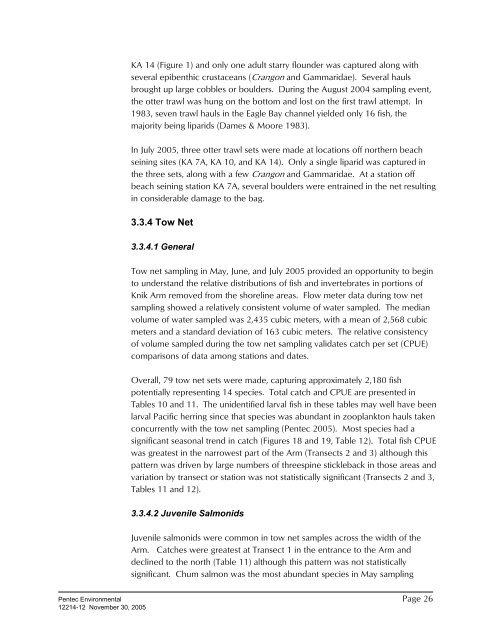Marine Fish and Benthos Studies - Knik Arm Bridge and Toll Authority
Marine Fish and Benthos Studies - Knik Arm Bridge and Toll Authority
Marine Fish and Benthos Studies - Knik Arm Bridge and Toll Authority
You also want an ePaper? Increase the reach of your titles
YUMPU automatically turns print PDFs into web optimized ePapers that Google loves.
KA 14 (Figure 1) <strong>and</strong> only one adult starry flounder was captured along with<br />
several epibenthic crustaceans (Crangon <strong>and</strong> Gammaridae). Several hauls<br />
brought up large cobbles or boulders. During the August 2004 sampling event,<br />
the otter trawl was hung on the bottom <strong>and</strong> lost on the first trawl attempt. In<br />
1983, seven trawl hauls in the Eagle Bay channel yielded only 16 fish, the<br />
majority being liparids (Dames & Moore 1983).<br />
In July 2005, three otter trawl sets were made at locations off northern beach<br />
seining sites (KA 7A, KA 10, <strong>and</strong> KA 14). Only a single liparid was captured in<br />
the three sets, along with a few Crangon <strong>and</strong> Gammaridae. At a station off<br />
beach seining station KA 7A, several boulders were entrained in the net resulting<br />
in considerable damage to the bag.<br />
3.3.4 Tow Net<br />
3.3.4.1 General<br />
Tow net sampling in May, June, <strong>and</strong> July 2005 provided an opportunity to begin<br />
to underst<strong>and</strong> the relative distributions of fish <strong>and</strong> invertebrates in portions of<br />
<strong>Knik</strong> <strong>Arm</strong> removed from the shoreline areas. Flow meter data during tow net<br />
sampling showed a relatively consistent volume of water sampled. The median<br />
volume of water sampled was 2,435 cubic meters, with a mean of 2,568 cubic<br />
meters <strong>and</strong> a st<strong>and</strong>ard deviation of 163 cubic meters. The relative consistency<br />
of volume sampled during the tow net sampling validates catch per set (CPUE)<br />
comparisons of data among stations <strong>and</strong> dates.<br />
Overall, 79 tow net sets were made, capturing approximately 2,180 fish<br />
potentially representing 14 species. Total catch <strong>and</strong> CPUE are presented in<br />
Tables 10 <strong>and</strong> 11. The unidentified larval fish in these tables may well have been<br />
larval Pacific herring since that species was abundant in zooplankton hauls taken<br />
concurrently with the tow net sampling (Pentec 2005). Most species had a<br />
significant seasonal trend in catch (Figures 18 <strong>and</strong> 19, Table 12). Total fish CPUE<br />
was greatest in the narrowest part of the <strong>Arm</strong> (Transects 2 <strong>and</strong> 3) although this<br />
pattern was driven by large numbers of threespine stickleback in those areas <strong>and</strong><br />
variation by transect or station was not statistically significant (Transects 2 <strong>and</strong> 3,<br />
Tables 11 <strong>and</strong> 12).<br />
3.3.4.2 Juvenile Salmonids<br />
Juvenile salmonids were common in tow net samples across the width of the<br />
<strong>Arm</strong>. Catches were greatest at Transect 1 in the entrance to the <strong>Arm</strong> <strong>and</strong><br />
declined to the north (Table 11) although this pattern was not statistically<br />
significant. Chum salmon was the most abundant species in May sampling<br />
Pentec Environmental Page 26<br />
12214-12 November 30, 2005
















